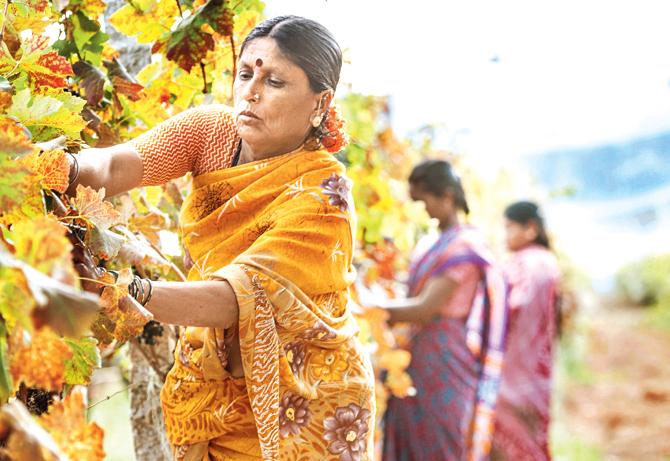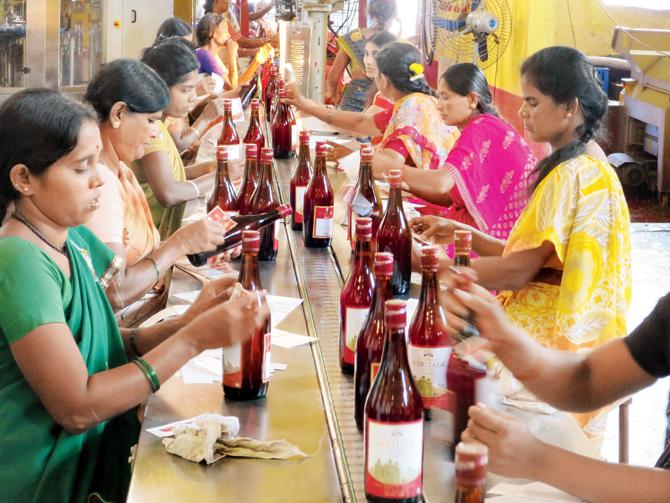From Nandi Hills to Igatpuri, Bijapur and Baramati, Peter Csizmadia-Honigh travels across the popular wine regions of the country. Hitch a ride

A worker at the Grover Zampa Vineyards in Nandi Hills, the South wine region of Karnataka
![]() Q. What made you choose the subject?
Q. What made you choose the subject?
A. I have been travelling to India for nine years. After having seen many, though not all, of the 'must-see' tourist attractions, I suggested to my husband that we visit wineries in 2012. So, we did a five-day whirlwind trip around Bangalore, Pune and Nashik. It was a great, even if a tiring way of understanding wine production in India. A few articles for magazines followed. During the desk research and writing, it became clear that there was no book or comprehensive information on Indian wines to refer to. So, an idea emerged to write a book, but it took me a while to take the bull by the horns. On a spring day in 2014, as I was on the double-decker to work, I came across (British wine critic) Jancis Robinson OBE, MW tweeting about a few days left to submit application for the Geoffrey Roberts Award. The award consisted of £4,000 as a grant to a project "promoting New World wines". I wondered whether India was too new of a New World country, but as advised by my husband, my job was to write a good application and the panel of trustees would decide. I was fortunate to be given the award and as such, the rest is history.

A worker at the Grover Zampa Vineyards in Nandi Hills, the South wine region of Karnataka. Pic courtesy/The Press Publishing (Gabor Nagy & Peter Csizmadia-Honigh)
ADVERTISEMENT
Q. How do the wines of India compare to their popular European counterparts?
A. The quality of Indian wines has changed enormously in the last nine years. It is a very young industry in India. So, it is nearly impossible, at this stage, to describe what makes a wine Indian or to pick out Indian wine from a line-up of a global bag. After a few more decades of production, a distinct Indian "identity" will be established. That said, Indian wines tend to show primacy of fruit in a straightforward manner. So, if I take one of the most important red varieties: Shiraz; you can make a distinction between, say, a Crozes Hermitage and Sula's Dindori Reserve Shiraz. The former is restrained, peppered and herbal, while the latter rich, generous and plush. However, there are Indian wines, which can proudly stand against international comparison. On price, Indian wines have tough competition; because production costs can often be high due to low mechanisation, high import demand for machinery equipment and increased cost of logistics throughout the distribution system. For example, in the UK market, it is the premium quality Indian wines that can compete on price as well. Entry-level wines would find it tough, if not impossible. There are still some "sad stories" where lack of expertise or capital to produce technically good quality products means their slow death, which may be sad at a personal level, but better for the industry and, of course, for consumers.

Peter Csizmadia-Honigh with day labourers at Elite Vintage Winery near Bijapur, Karnataka
Q. Tell us about the research that went into the book.
A. It took 15 months. When I got to know that I was given the award, I realised I had to make changes. After nine enjoyable and successful years at the Institute of Masters of Wine in London, I decided it was time to go alone, so I left my job and set up The Press Publishing Ltd. With the help of Pune-based Sujata Patil, it took three months to set up my itinerary and do the pre-field-trip research. I spent November, December and January in India, travelling to all the wineries, from Then in Tamil Nadu up to Titari Village near Ratlam in Madhya Pradesh. I visited producers, regardless of their size, quality or location, travelling by air, car or train. It was most humbling to experience the warm welcome and generous hospitality of all producers, who opened their doors, shared their knowledge and tasted bottle after bottle with me during these three months. I returned with Gabor Nagy, the photographer, in March this year to capture the images of the book. From February to the end of September, I buried myself into the nitty-gritty jobs that you need to get done. The book was launched in Mumbai, London and Hungary.

Bottling at Heritage Grape Winery. Pics courtesy/ The Press Publishing Gabor Nagy & Peter Csizmadia-Honigh
What have been some of the learnings and unlearnings from your research?
A: The biggest learning, or re-confirmation of my belief, was that if you are humble and interested, people will generously share their insights and knowledge with you. Another learning was that you may be humble and interested, but you must also be single-mindedly focussed to remain on track and work according to your plans because there are so many distractions in life and that is especially true in India. As for wine, I'd suggest take a look at the book, read the stories and you will discover the vinous learnings in my writing.

A cellar hand cleans the tank of pomace (solid remains of fruits) after fermentation in the winery at Grover Zampa Vineyards, Bangalore in the South wine region, Karnataka
What were some of the most intriguing/surprisings finds with regards to wines in India?
A: It was intriguing to understand that producers of sub-entry-level wines can harvest and make wine 365 days a year in order to eliminate the need for keeping large stocks. I was surprised to see how many defunct wineries were still around with shabby business practices making a huge problem for the industry. I was intrigued to better understand that the Government of India will be able to help the wine industry and tackle alcohol related issues only by cutting through the Gordian knot rather than fiddling with smaller matters at state level. Decisive and progressive action must be taken in consultation with the industry
 Subscribe today by clicking the link and stay updated with the latest news!" Click here!
Subscribe today by clicking the link and stay updated with the latest news!" Click here!







